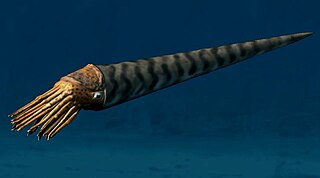
Orthoceras is a genus of extinct nautiloid cephalopod restricted to Middle Ordovician-aged marine limestones of the Baltic States and Sweden. This genus is sometimes called Orthoceratites. Note it is sometimes misspelled as Orthocera, Orthocerus or Orthoceros.

The Phacopina comprise a suborder of the trilobite order Phacopida. Species belonging to the Phacopina lived from the Lower Ordovician (Tremadocian) through the end of the Upper Devonian (Famennian). The one unique feature that distinguishes Phacopina from all other trilobites are the very large, separately set lenses without a common cornea of the compound eye.

Rissooidea, originally named Rissoacea by Gray, 1847, is a taxonomic superfamily of small and minute marine snails, belonging to the clade Littorinimorpha.
Raymond Cecil Moore was an American geologist and paleontologist. He is known for his work on Paleozoic crinoids, bryozoans, and corals. Moore was a member of US Geological Survey from 1913 until 1949. In 1919 he became professor at the University of Kansas (Lawrence). In 1953 Professor Moore organized the launch and became the first editor of the still ongoing multi-volume work Treatise on Invertebrate Paleontology. Contributors to the Treatise have included the world's specialists in the field. He served as president of the Geological Society of America in 1958. In 1970 he was awarded the Mary Clark Thompson Medal from the National Academy of Sciences.

Euproops is an extinct genus of xiphosuran, related to the modern horseshoe crab. It lived in the Carboniferous.
The Tarphycerida were the first of the coiled cephalopods, found in marine sediments from the Lower Ordovician to the Middle Devonian. Some, such as Aphetoceras and Estonioceras, are loosely coiled and gyroconic; others, such as Campbelloceras, Tarphyceras, and Trocholites, are tightly coiled, but evolute with all whorls showing. The body chamber of tarphycerids is typically long and tubular, as much as half the length of the containing whorl in most, greater than in the Silurian Ophidioceratidae. The Tarphycerida evolved from the elongated, compressed, exogastric Bassleroceratidae, probably Bassleroceras, around the end of the Gasconadian through forms like Aphetoceras. Close coiling developed rather quickly, and both gyroconic and evolute forms are found in the early middle Canadian.
Zetoceras is an extinct ammonoid cephalopod genus from the suborder Phylloceratina that lived during the Early and Middle Jurassic in what is now Europe, and is included in the (family) Phylloceratidae.
Ancyloceratoidea, formerly Ancylocerataceae, is a superfamily of typically uncoiled and loosely coiled heteromorph ammonoids established by Alpheus Hyatt in 1900, that may contain as many as 11 families, depending on the classification accepted.
The Bassleroceratidae is a family of gradually expanding, smooth ellesmerocerids with a slight to moderate exogastric curvature, subcircular to strongly compressed cross section, and ventral orthochaonitc siphuncle. The ventral side is typically more sharply rounded than the dorsal side and septa are close spaced. Connecting rings are thick and slightly expanded into the siphuncle, making the segments slightly concave; characteristic of the Ellesmerocerida.
Ceratitoidea, formerly Ceratitaceae, is an ammonite superfamily in order Ceratitida characterized in general by highly ornamented or tuberculate shells with ceratitic sutures that may become goniatitic or ammonitic in some offshoots.

Acanthoceratoidea, formerly Acanthocerataceae, is a superfamily of Upper Cretaceous ammonoid cephalopods belonging to the order Ammonitida, and comprising some 10 or so families.

Rhynchonelliformea is the name now given to the articulate brachiopods, Class Articulata, revised as a subphylum. Articulate brachiopods are those with hard, articulated shells with a simple set of opening and closing muscles.
The Pinacoceratoidea are generally smooth, compressed, evolute to involute ammonoids from the Triassic, belonging to the Ceratitida, in which the suture is ammonitic, with adventitious and auxiliary elements.

Perisphinctoidea, formerly Perisphinctaceae, is a superfamily of Middle Jurassic (Bajocian) to Lower Cretaceous (Barremian) ammonites, commonly with evolute shells with strong ribbing that typically divides about mid flank before crossing the venter.
Cravevoceras is an Upper Paleozoic ammonite in the gonititid family Cravenoceratidae, probably derived from Pachylyroceras and contemporary with other cravenoceratid genera like Caenolyroceras, Tympanoceras and later Alaoceras and Lyrogoniatites. It is also a member of the Neoglyphiocerataceae.

Hildoceratidae is a family of ammonoid cephalopods from the Lower Jurassic, lower Pliensbachian to lower Bajocian substages, generally with strongly ribbed, involute shells. They are combined with the Hammatoceratidae, Graphoceratidae, and Sonniniidae to make up the Hildoceratoidea.

Perisphinctidae is a family of Middle and Upper Jurassic discoidal ammonites in the order Ammonitida. They have a shell morphology that is mostly evolute, typically with biplicate, simple, or triplicate ribbing. Large forms have simple apertures and smooth body chambers while small forms have lappets and ribbed body chambers.
Ecdyceras is a genus in the Ascocerida doubtfully assigned to the Hebetoceratidae. It somewhat resembles Hebetoceras.









